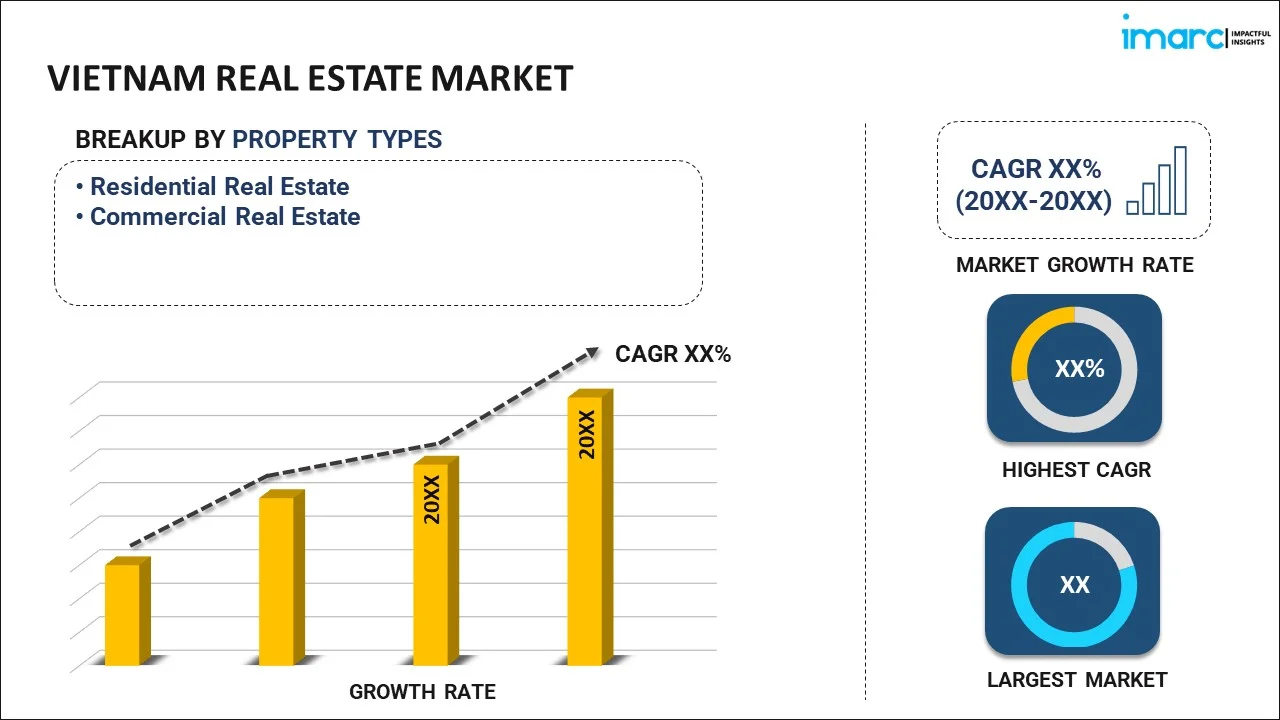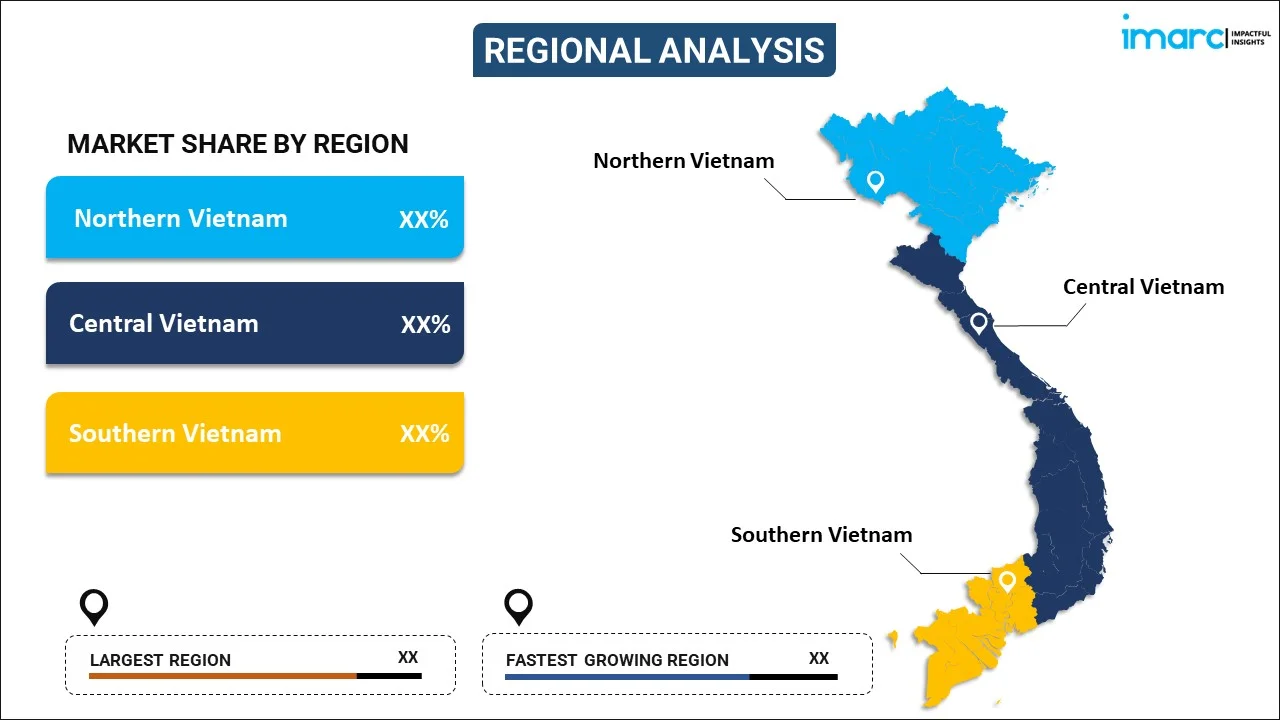
Vietnam Real Estate Market Report by Property Type (Residential Real Estate, Commercial Real Estate), and Region 2025-2033
Market Overview:
Vietnam real estate market size is projected to exhibit a growth rate (CAGR) of 1.70% during 2025-2033. The growing need for a consistent source of income, increasing number of residential development projects as people are moving from rural areas to urban centers, and favorable government initiatives represent some of the key factors driving the market.
|
Report Attribute
|
Key Statistics
|
|---|---|
|
Base Year
|
2024 |
|
Forecast Years
|
2025-2033
|
|
Historical Years
|
2019-2024
|
| Market Growth Rate (2025-2033) | 1.70% |
Real estate comprises properties, such as land, buildings, and infrastructure, and offers opportunities to individuals and companies for acquiring and owning property. It can generate rental income when properties are leased to tenants or provide a space for business operations. It can serve as a hedge against inflation, diversify an investment portfolio, and can help reduce overall investment risk. It allows investors to have more control over their investments as compared to stocks or bonds. It enables individuals to build wealth over the long term through property appreciation and provides a consistent source of rental income. It allows people to choose the type of properties that align with their investment goals and risk tolerance. It helps real estate investors in benefiting from various tax deductions, including mortgage interest, property taxes, and depreciation. Besides this, it enables individuals in purchasing a property with a relatively small down payment and financing the rest with a mortgage. As it is beneficial in providing a source of retirement income and generating cash flow, the demand for real estate is increasing in Vietnam.
Vietnam Real Estate Market Trends:
At present, the rising number of shopping malls, supermarkets, and other retail spaces represents one of the primary factors impelling the growth of the market in Vietnam. In line with this, the growing demand for hospitality and vacation properties due to the thriving tourism sector in the country is offering a positive market outlook. In addition, the increasing focus on constructing medical facilities is supporting the market growth. Apart from this, there is a rise in the need for a consistent source of income among the masses in Vietnam. This, coupled with the increasing number of residential development projects, as people are moving from rural areas to urban centers in search of enhanced opportunities, is strengthening the market growth. Moreover, governing agencies in Vietnam are investing in infrastructure, such as transportation networks and utilities, which enhance connectivity and accessibility. They are also providing incentives and policies, such as tax breaks and land lease terms, which are propelling the market growth. In line with this, the rising focus on sustainable and eco-friendly building practices that reduce environmental pollution is offering lucrative growth opportunities to industry investors in the country. Furthermore, the increasing adoption of digital technologies in real estate, including online property listings and virtual tours, to provide enhanced convenience to people is contributing to the market growth.
Vietnam Real Estate Market Segmentation:
IMARC Group provides an analysis of the key trends in each segment of the market, along with forecasts at the country level for 2025-2033. Our report has categorized the market based on property type.
Property Type Insights:

- Residential Real Estate
- Apartments
- Villas
- Others
- Commercial Real Estate
- Offices
- Retail
- Hospitality
- Others
A detailed breakup and analysis of the market based on the property type have also been provided in the report. This includes residential real estate (apartments, villas, and others) and commercial real estate (offices, retail, hospitality, and others).
Regional Insights:

- Northern Vietnam
- Central Vietnam
- Southern Vietnam
The report has also provided a comprehensive analysis of all the major regional markets, which include Northern Vietnam, Central Vietnam, and Southern Vietnam.
Competitive Landscape:
The market research report has also provided a comprehensive analysis of the competitive landscape in the market. Competitive analysis such as market structure, key player positioning, top winning strategies, competitive dashboard, and company evaluation quadrant has been covered in the report. Also, detailed profiles of all major companies have been provided.
Vietnam Real Estate Market Report Coverage:
| Report Features | Details |
|---|---|
| Base Year of the Analysis | 2024 |
| Historical Period | 2019-2024 |
| Forecast Period | 2025-2033 |
| Units | US$ Million |
| Scope of the Report | Exploration of Historical and Forecast Trends, Industry Catalysts and Challenges, Segment-Wise Historical and Predictive Market Assessment:
|
| Property Types Covered |
|
| Regions Covered | Northern Vietnam, Central Vietnam, Southern Vietnam |
| Customization Scope | 10% Free Customization |
| Report Price and Purchase Option | Single User License: US$ 3699 Five User License: US$ 4699 Corporate License: US$ 5699 |
| Post-Sale Analyst Support | 10-12 Weeks |
| Delivery Format | PDF and Excel through Email (We can also provide the editable version of the report in PPT/Word format on special request) |
Key Questions Answered in This Report:
- How has the Vietnam real estate market performed so far and how will it perform in the coming years?
- What has been the impact of COVID-19 on the Vietnam real estate market?
- What is the breakup of the Vietnam real estate market on the basis of property type?
- What are the various stages in the value chain of the Vietnam real estate market?
- What are the key driving factors and challenges in the Vietnam real estate?
- What is the structure of the Vietnam real estate market and who are the key players?
- What is the degree of competition in the Vietnam real estate market?
Key Benefits for Stakeholders:
- IMARC’s industry report offers a comprehensive quantitative analysis of various market segments, historical and current market trends, market forecasts, and dynamics of the Vietnam real estate market from 2019-2033.
- The research report provides the latest information on the market drivers, challenges, and opportunities in the Vietnam real estate market.
- Porter's five forces analysis assist stakeholders in assessing the impact of new entrants, competitive rivalry, supplier power, buyer power, and the threat of substitution. It helps stakeholders to analyze the level of competition within the Vietnam real estate industry and its attractiveness.
- Competitive landscape allows stakeholders to understand their competitive environment and provides an insight into the current positions of key players in the market.
Need more help?
- Speak to our experienced analysts for insights on the current market scenarios.
- Include additional segments and countries to customize the report as per your requirement.
- Gain an unparalleled competitive advantage in your domain by understanding how to utilize the report and positively impacting your operations and revenue.
- For further assistance, please connect with our analysts.
 Inquire Before Buying
Inquire Before Buying
 Speak to an Analyst
Speak to an Analyst
 Request Brochure
Request Brochure
 Request Customization
Request Customization




.webp)




.webp)












